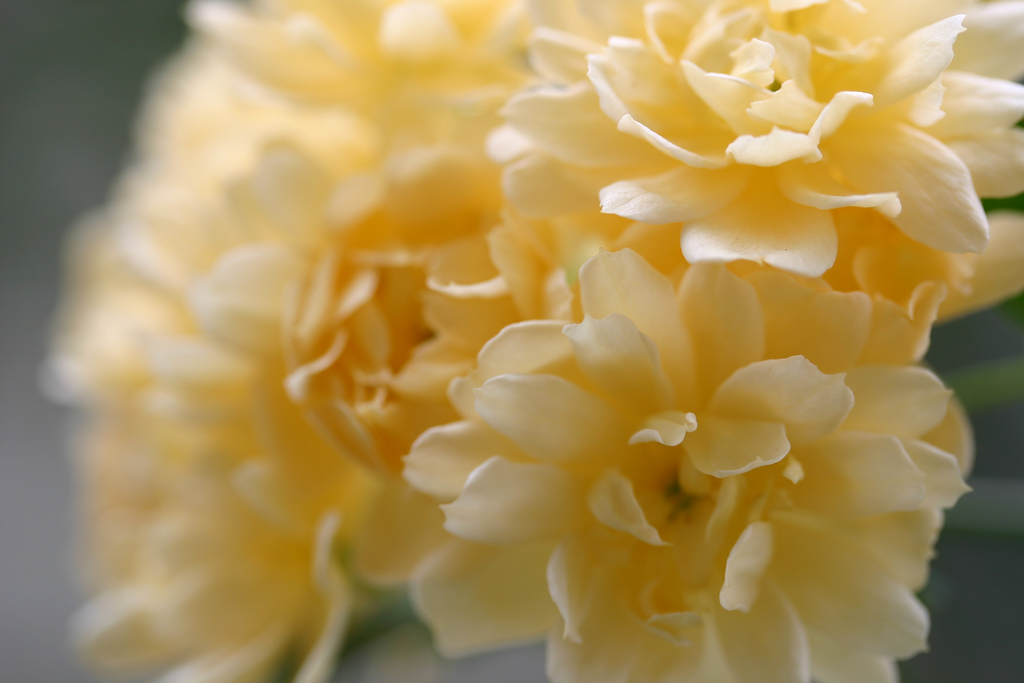- Rosa banksiae
Taxobox
name = "Rosa banksiae"

image_width = 240px
regnum =Plant ae
divisio = Magnoliophyta
classis =Magnoliopsida
ordo =Rosales
familia =Rosaceae
subfamilia =Rosoideae
genus = "Rosa"
species = "R. banksiae"
binomial = "Rosa banksiae"
binomial_authority = Aiton"Rosa banksiae", commonly referred to as the Lady Banks' Rose, is a species of "Rosa" native to central and western
China , in the provinces ofGansu ,Guizhou ,Henan ,Hubei ,Jiangsu ,Sichuan , andYunnan ; it grows in mountains at altitudes of 500-2200 m.It is a scrambling
shrub byliana growing vigorously over other shrubs to 6 m tall. Unlike most roses, it is practically thornless, though may bear some prickles up to 5 mm long, particularly on stout, strong shoots. The leaves areevergreen , 4-6 cm long, with three to five (rarely seven)leaflets 2-5 cm long with a serrated margin. Theflower s are small, 1.5-2.5 cm diameter, white or pale yellow.There are two varieties:
*"Rosa banksiae" var. "banksiae". Flowers semi-double or double, with numerous petals replacing most or all of thestamen s; acultigen developed in Chinese gardens.
*"Rosa banksiae" var. "normalis" Regel. Flowers single, with five petals; the natural wild form of the species.The rose is named after Lady Banks, the wife of the eminent botanist
Sir Joseph Banks (after whom theBanks Peninsula is named).Cultivation and uses
"R. banksiae" has likely been grown in the gardens of China for hundreds of years. The species was introduced to Europe by
William Kerr , who had been sent on a plant-hunting expedition by Sir Joseph. He bought the first Lady Banks' Rose, subsequently named the 'White Lady Banks' ("R. banksiae" var. "banksiae") from the famousFa Tee nursery in 1807. A number of other forms were subsequently discovered growing in China, The white, small-flowered "R. banksiae" var. "normalis" (1796) is considered the "wild" form; 'Banksiae Lutea', the 'Yellow Lady Banks' Rose, probably the most popular (brought to Europe in 1824 by J. D. Park); and "R. banksiae" 'Lutescens', a rose with light yellow blooms. All Lady Banks' roses are said to smell ofviolets to varying degrees.According to Guinness, the world's largest rosebush was planted in
Tombstone, Arizona in 1885 and still flourishes today in the city's sunny climate. This rose bush now covers 8,000 square feet of the roof on an inn, and has a 12-foot circumference trunk.References
* [http://www.efloras.org/florataxon.aspx?flora_id=2&taxon_id=200011215 Flora of China: "Rosa banksiae"]
* [http://www.tombstonetimes.com/stories/rose.html Tombstone's Shady Lady]
*"Climbing Roses of the World" by Charles Quest-Ritson
*"The Graham Stuart Thomas Rose Book" by Graham Stuart Thomas
Wikimedia Foundation. 2010.
